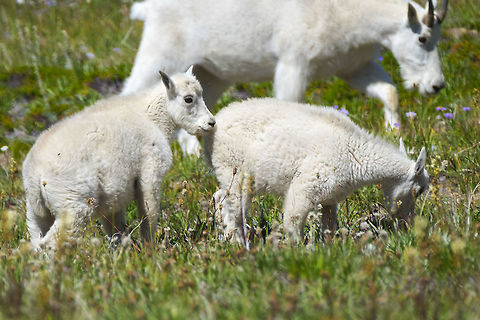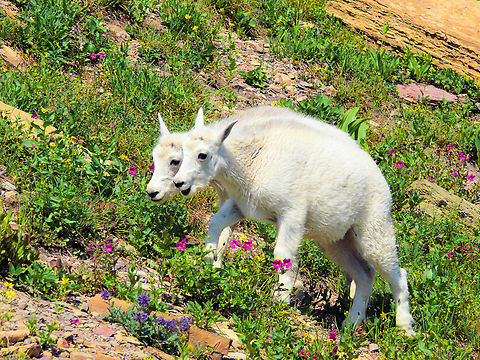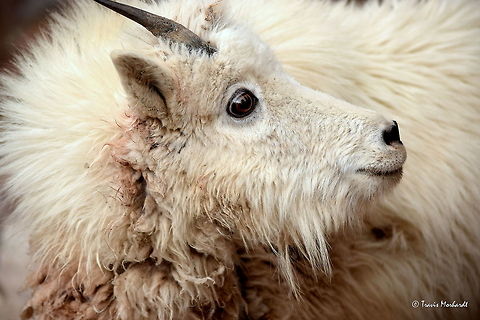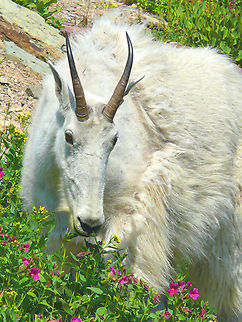
Appearance
Both male and female mountain goats have beards, short tails, and long black horns, 15–28 cm in length, which contain yearly growth rings. They are protected from the elements by their woolly white double coats. The fine, dense wool of their undercoats is covered by an outer layer of longer, hollow hairs. Mountain goats molt in spring by rubbing against rocks and trees, with the adult bucks shedding their extra wool first and the pregnant does shedding last. Their coats help them to withstand winter temperatures as low as −50 °F and winds of up to 100 mph.A buck stands about 1 m at the shoulder to the waist and can weigh considerably more than the female. Male goats also have longer horns and longer beards than females. Mountain goats can weigh between 45 and 140 kg, though even males will often weigh less than 82 kg. The head-and-body length can range from 120–179 cm, with a small tail adding 10–20 cm.
The mountain goat's feet are well-suited for climbing steep, rocky slopes with pitches exceeding 60°, with inner pads that provide traction and cloven hooves that can spread apart. The tips of their feet have sharp dewclaws that keep them from slipping.

Behavior
This section does not any. Please help improve this section by adding citations to reliable sources. Unsourced material may be challenged and. "In the wild, mountain goats usually live 12 to 15 years, with their lifespans limited by the wearing down of their teeth. In zoos, however, they can live for 16 to 20 years.
Mountain goats reach sexual maturity at about 30 months. Nannies in a herd undergo synchronized estrus in late October through early December, at which time males and females participate in a mating ritual. Mature billies will stare at nannies for long periods, dig rutting pits, and fight each other in showy scuffles. Young billies sometimes try to participate, but they are ignored by nannies; nannies will also sometimes pursue inattentive billies. Both males and females usually mate with multiple individuals during breeding season, although some billies try to keep other males away from certain nannies. After the breeding season is over, males and females move away from each other, with the adult billies breaking up into small bands of two or three individuals. Nannies form loose-knit nursery groups of up to 50 animals.
Kids are born in the spring after a six-month gestation period. Nannies give birth, usually to a single offspring, after moving to an isolated ledge;" post partum", they lick the kid dry and ingest the placenta. Kids weigh a little over 3 kg at birth and begin to run and climb within hours. Although they are mostly weaned within one month, kids follow their mothers closely for the first year of life; nannies protect their young by leading them out of danger, standing over them when faced by predators, and positioning themselves below their kids on steep slopes to stop freefalls.Nannies can be very competitive and protective of their space and food sources. They will fight with one another for dominance in conflicts that can ultimately include all the nannies in the herd. In these battles, nannies will circle each other with their heads lowered, displaying their horns. As with fights between billies during breeding season, these conflicts can occasionally lead to injury or death, but are usually harmless. To avoid fighting, an animal may show a posture of nonaggression by stretching low to the ground.
In regions below the tree line, nannies use their fighting abilities to protect themselves and their offspring from predators. Predators, including wolves, wolverines, lynx and bears, will attack goats of most ages given the opportunity. The cougar is perhaps the primary predator, being powerful enough to overwhelm the largest adults and uniquely nimble enough to navigate the rocky ecosystem of the goats. Though their size protects them from most potential predators in higher altitudes, nannies must defend their young from golden eagles, which can be a major predatory threat to kids. Nannies have even been observed trying to dominate the more passive but often heavier bighorn sheep that share some of their territory.
Mountain goats can occasionally be aggressive towards humans, with at least one reported fatality resulting from an attack by a mountain goat.

Habitat
The mountain goat inhabits the Rocky Mountains and Cascade Range regions of North America, from Washington, Idaho and Montana through British Columbia and Alberta, into the southern Yukon and southeastern Alaska. Its northernmost range is said to be along the northern fringe of the Chugach Mountains in southcentral Alaska. Introduced populations can also be found in such areas as Idaho, Wyoming, Utah, Nevada, Oregon, Colorado, Texas, South Dakota, and the Olympic Peninsula of Washington.Mountain goats are the largest mammals found in their high-altitude habitats, which can exceed elevations of 13,000 feet. They sometimes descend to sea level in coastal areas although they are primarily an alpine and subalpine species. The animals usually stay above the tree line throughout the year but they will migrate seasonally to higher or lower elevations within that range. Winter migrations to low-elevation mineral licks often take them several kilometers through forested areas.

Food
Mountain goats are herbivores and spend most of their time grazing. Their diets include grasses, herbs, sedges, ferns, mosses, lichens, and twigs and leaves from the low-growing shrubs and conifers of their high-altitude habitat.In captivity, the mountain goat's diet can also include grain, alfalfa, fruits, and vegetables, and grass.
References:
Some text fragments are auto parsed from Wikipedia.